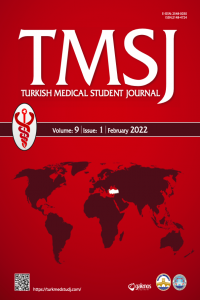CAENORHABDITIS ELEGANS AND ANGIOGENESIS
CAENORHABDITIS ELEGANS AND ANGIOGENESIS
Abstract: Angiogenesis is sprouting of new capillaries from already existing ones. It is a dynamic process that can be seen in every phase of human life. It is among the dynamic mechanisms of both physiological and pathological processes. Vascular endothelial growth factor is one of the many molecules that play a role in angiogenesis. Vascular endothelial growth factor is released specifically to the endothelium. It regulates mitogenesis, vascular tone, vascular permeability and vasodilatation in the vascular endothelium. Caenorhabditis elegans is a nematode used to detect and screen the developmental processes and genetic mutations. It is appropriate to study at the organism level to isolate cells and to demonstrate intercellular interactions in vivo. Polyvinyl fluoride-1 is a molecule that plays a role in the neural development of Caenorhabditis elegans. In addition, the polyvinyl fluoride-1 molecule is told to be effective in angiogenesis. Studies have shown that polyvinyl fluoride-1 binds to vascular endothelial growth factor receptor-1 and vascular endothelial growth factor receptor-2, but not to vascular endothelial growth factor receptor-3 and platelete derivated growth factor receptor β. In the research of human umbilical vein endothelial lines, it was observed that polyvinyl fluoride-1 induced angiogenesis and vascular tube formation. These results suggest that Caenorhabditis elegans may have a very important role in vascular endothelial growth factor studies. Caenorhabditis elegans model is used in many scientific areas such as aging, nervous system and genetic changes. However, only a few laboratories around the world studied the Caenorhabditis elegans angiogenesis model. Besides, this model is not currently used in Turkey. This provides a great advantage in terms of the utilization of this model in angiogenesis.
___
- 1. Adair TH, Montani JP. Overview of Angionesis. Angiogenesis (online) 2010 (cited 2019 Jan 5). Available from: URL: https://www.ncbi.nlm.nih.gov/books/ NBK53238/.
- 2. Folkman J. Tumor angiogenesis: therapeutic implications. N Engl J Med 1971;285(21):1182-8.
- 3. Rao DA, Mishra G, Doddapaneni BS et al. Combinatorial polymeric conjugated micelles with dual cytotoxic and antiangiogenic effects for the treatment of ovarian cancer. Chemistry of Materials 2016;28:6068– 79.
- 4. Adams RH, Alitalo K. Molecular regulation of angiogenesis and lymphangiogenesis. Nature Reviews Molecular Cell Biology 2007;8(6):464-78.
- 5. Ng YS, Krilleke D, Shima DT. VEGF function in vascular pathogenesis. Experimental Cell Research 2006;312(5):527-37.
- 6. Takahashi H, Shibuya M. The vascular endothelial growth factor (VEGF)/ VEGF receptor system and its role under physiological and pathological conditions. Clinical Science 2005;109(3):227-41.
- 7. Duffy AM, Bouchier-Hayes DJ, Harmey JH. Vascular edothelial growth factor (VEGF) and its role in non-endothelial cells: autocrine signalling by VEGF. Madame Curie Bioscience Database 2000-2013. Available from: URL: https://www.ncbi.nlm.nih.gov/books/NBK6482/.
- 8. Rahimi N. Vascular endothelial growth factor receptors: molecular mechanisms of activation and therapeutic potentials. Exp Eye Res 2006;83(5):1005-16.
- 9. Stacker SA. Achen MG. Emerging roles for VEGF-D in human disease. Biomolecules 2018;8(1):1.
- 10. Lange C, Storkebaum E, Almodovar CR et al. Vascular endothelial growth factor: a neurovascular target in neurological diseases. Nature Reviews Neurology 2016;12:439-54.
- 11. Häggströmr M. Interactions of VEGF ligands and VEGF receptors (online) 2014 (cited 2019 Jan 5). Available from: URL: https://en.wikiversity.org/wiki/ WikiJournal_of_Medicine/Medical_gallery_of_Mikael_H%C3%A4gg tr%C3%B6m_2014#/media/File:VEGF_receptors.png.
- 12. Corsi AK, Wightman B, Chalfie M. A transparent window into biology: a primer on caenorhabditis elegans (online) 2015 (cited 2019 Jan 5). Available from: URL: http://www.wormbook.org/chapters/www_celegansintro/celegansintro.pdf.
- 13. Schroeder KD. Caenorhabditis elegans hermaphrodite adult (online) 2013 (cited 2019 Jan 5). Available from: URL: https://commons.wikimedia.org/w/index. php?curid=26958836.
- 14. Tarsitano M, De Falco S, Colonna V et al. The C. elegans pvf-1 gene encodes a PDGF/VEGF-like factor able to bind mammalian VEGF receptors and to induce angiogenesis. FASEB J 2006;20(1):227-33.
- 15. Dalpe G, Tarsitano M, Persico MG et al. C. elegans PVF-1 inhibits permissive UNC-40 signalling through CED-10 GTPase to position the male ray 1 sensillum. Development 2013;140(19):4020-30.
- ISSN: 2148-4724
- Başlangıç: 2014
- Yayıncı: Trakya Üniversitesi
Sayıdaki Diğer Makaleler
Ali Rıza AVUL, Büşra ÖZDEMİR, Gülay Durmuş ALTUN
AN INVESTIGATION ON THE ANTICANCER EFFECT OF SPIDER WEB IN HUMAN CERVICAL CELL LINE
Aslı Nur ÖZKAN, Oğuzhan DOĞANLAR
THE INFLUENCE OF INTERCURRENT DISEASES ON THE COURSE OF HIV IN ASSOCIATION WITH ACTIVE TUBERCULOSIS
Tetiana Kolotylo, Hennadii PETROCHENKOV, Orest GRİTSİUK
EVALUATION OF MALNUTRITION STATUSES IN SYSTOLIC HEART FAILURE PATIENTS
İrmak İrem ÖZYİĞİT, Beliz KOÇYİĞİT, Begüm SÖYLEYİCİ, Fatih Mehmet UÇAR
CAENORHABDITIS ELEGANS AND ANGIOGENESIS
İbrahim KILIÇÇALAN, Abdulbaki ERKOVAN, Emine ŞEN
SYSTEMIC CANNABIDIOL DOES NOT REDUCE COMPOUND 48/80-INDUCED ITCHING BEHAVIOR IN MICE
Hatice Demirel, Elif Baksın, Ece Önay Özgür, Ruhan Deniz Topuz, Ahmet ULUGÖL
